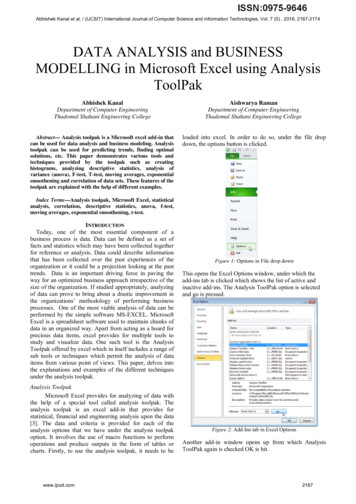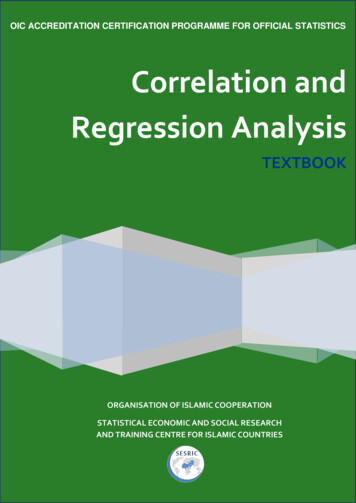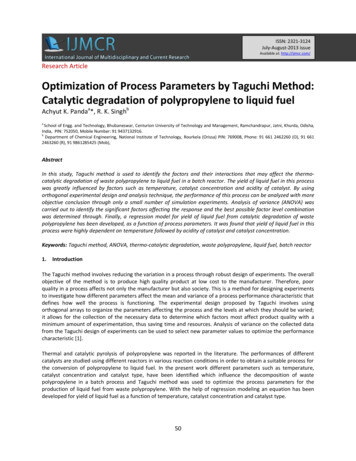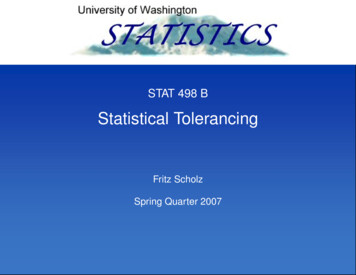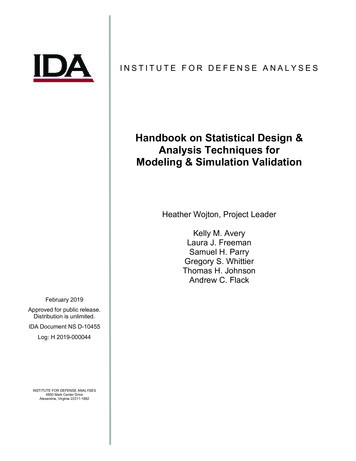
Transcription
INSTITUTE FOR DEFENSE ANALYSESHandbook on Statistical Design &Analysis Techniques forModeling & Simulation ValidationHeather Wojton, Project LeaderKelly M. AveryLaura J. FreemanSamuel H. ParryGregory S. WhittierThomas H. JohnsonAndrew C. FlackFebruary 2019Approved for public release.Distribution is unlimited.IDA Document NS D-10455Log: H 2019-000044INSTITUTE FOR DEFENSE ANALYSES4850 Mark Center DriveAlexandria, Virginia 22311-1882
About This PublicationThis work was conducted by the Institute for Defense Analyses (IDA) under contract HQ0034-14-D-0001, TaskBD-9-2299(90), “Test Science Applications,” for the Office of the Director, Operational Test and Evaluation. Theviews, opinions, and findings should not be construed as representing the official position of either theDepartment of Defense or the sponsoring organizationAcknowledgmentsThe IDA Technical Review Committee was chaired by Mr. Robert R. Soule and consisted of Denise J. Edwards,Douglas A. Peek, Jason P. Sheldon, Robert M. Hueckstaedt, Sabrina Lyn Hiner Dimassimo, and William G.Gardner from the Operational Evaluation Division, and Nathan Platt and James M. Gilmore from the SystemsEvaluation Division. Thanks also to Chris Henry, Jane Pinelis, Dave Beyrodt, Stargel Doane, Doug Ray, andSimone Youngblood for their valuable contributions to this project.For more information:Heather Wojton, Project Leaderhwojton@ida.org (703) 845-6811Robert R. Soule, Director, Operational Evaluation Divisionrsoule@ida.org (703) 845-2482Copyright Notice 2019 Institute for Defense Analyses4850 Mark Center Drive, Alexandria, Virginia 22311-1882 (703) 845-2000This material may be reproduced by or for the U.S. Government pursuant to the copyright license under theclause at DFARS 252.227-7013 (a)(16) [Jun 2013].
INSTITUTE FOR DEFENSE ANALYSESIDA Document NS D-10455Handbook on Statistical Design &Analysis Techniques forModeling & Simulation ValidationHeather Wojton, Project LeaderKelly M. AveryLaura J. FreemanSamuel H. ParryGregory S. WhittierThomas H. JohnsonAndrew C. Flack
Executive SummaryEvaluations of system operational effectiveness, suitability, and survivabilityincreasingly rely on models to supplement live testing. In order for these supplements tobe valuable, testers must understand how well the models represent the systems orprocesses they simulate. This means testers must quantify the uncertainty in therepresentation and understand the impact of that uncertainty.Two broad categories of uncertainties (statistical and knowledge) are of centralimportance to test and evaluation (T&E), particularly as testers try to extrapolate the modeloutput and live test data into predictions of performance in combat. The validation processshould include parametric analyses and a comparison of simulation output to live data tosupport quantification of statistical uncertainty. However, qualitative and non-statisticaltechniques may also be required to compare the future hypothetical combat environmentwith the non-quantitative portions of the validation referent.A model’s intended use stipulates the fidelity and type of model necessary. Intendeduse is based on the model’s overarching purpose (model hierarchy); the quantities ofinterest for evaluation (response variables); the range of input conditions for the model; therange of input conditions over which experimental data (live testing) can be collected; andthe acceptability criteria (typically stated as an allowable difference between the model andlive data). Determining which uncertainty and how much uncertainty matters for amodeled system or process requires detailed understanding of the model, the system undertest, and the model’s specific intended useThe goal of this handbook is to aid the T&E community in developing test strategiesthat support data-driven model validation and uncertainty quantification. Chapter 2 of thehandbook discusses the overarching steps of the verification, validation, and accreditation(VV&A) process as it relates to operational testing. Chapter 3 describes analytical methodsfor analyzing the simulation itself, making comparisons with the live data, and quantifyingthe associated uncertainties. Chapter 4 outlines design of experiment techniques and theirapplication to both live and simulation environments.ProcessThe purpose of this chapter is to outline in detail the VV&A process for using modelsand simulations to augment operational test and evaluation (OT&E). It also providesgeneral principles for achieving a meaningful accreditation.i
Once the T&E community has determined that a model or simulation is required tosupport operational evaluation, then the VV&A process can commence. This process iscomprised of nine steps:1. Develop the intended use statement2. Identify the response variables or measures3. Determine the factors that are expected to affect the response variable(s) or thatare required for operational evaluation4. Determine the acceptability criteria5. Estimate the quantity of data that will be required to assess the uncertaintywithin the acceptability criteria.6. Iterate the Model-Test-Model loop until desired model fidelity is achieved7. Verify that the final instance of the simulation accurately represents the intendedconceptual model (verification process).8. Determine differences between the model and real-world data for acceptabilitycriteria of each response variable using appropriate statistical methods(validation process).9. Identify the acceptability of the model or simulation for the intended use.The successful implementation of this process is contingent on the tester, modeler,and user communities working together and communicating early and often. The VV&Astrategy, including the associated acceptability criteria, has routinely been developed toolate (or not at all) for operational evaluations. This practice creates unacceptable risk thatthe delivered models will not support their intended use for operational evaluations, or thatthe intended use will need to be significantly limited from that originally planned.Statistical concepts and methodologies can be incorporated throughout this VV&Aprocess. Table 1 correlates statistical ideas to the appropriate steps in the V&V process.ii
Table 1. Correlating Statistical Concepts to the VV&A ProcessAnalysisStatistical analyses can and should inform VV&A decision makers by providinginformation about model performance across the input space and by identifying risk areas.In addition to discussing inherent limitations of the model in terms of knowledgeuncertainty, a good validation analysis should characterize the performance of the modelacross the operational space and quantify the statistical uncertainty associated with thatperformance. Inappropriate analysis techniques, such as those that average or roll upinformation despite the data being collected in distinct operational conditions, can lead toincorrect conclusions.Evaluations should ultimately be based on both statistical and operational knowledge.Subject matter expertise is critical for answering the question, “Do the identified statisticaldifferences actually make a practical difference?” Accreditation reports should use allrelevant information to discuss what the model is useful for and what it is not.After thoroughly exploring and visualizing the data, testers should evaluate thesimulation on its own (to include sensitivity analysis and statistical emulators) and comparesimulation results with the live test data (external validation). Sensitivity analysis can referto either large changes in the inputs to build parametric emulators (parametric analysis) orsmall changes in inputs to look for bugs in code and reasonable perturbations in outputs.In this context, sensitivity analysis is used to determine how different values of an inputvariable affect a particular simulation output variable. Statistical emulators, also known asmeta-models, use simulation output from across a set of conditions (ideally a designedexperiment) to build a statistical model. An emulator can be used to estimate uncertaintyand predict the output of the simulation at both tested and untested conditions.The most appropriate method for statistically comparing live data and simulatedoutput will depend on a variety of circumstances. There is no one-size-fits-all solution. Insome cases, it may be useful or necessary to apply multiple techniques in order to fullyunderstand and describe the strengths and weaknesses of the model. Generally speaking,iii
statistical validation techniques that account for possible effects due to factors are preferredover one-sample averages or roll-ups across conditions. If a designed experiment wasexecuted in the live environment, an appropriate statistical modeling approach should beused to comparing the live data and simulated output. In all cases, even if no factors areidentified and a one-sample approach is taken, it is crucial that the uncertainty about thedifference between live data and simulated output be quantified. Hypothesis tests andconfidence intervals are simple ways to quantify statistical uncertainty. Table 2 shows ourrecommended validation analysis methods based on response variable distribution, factorstructure, and sample size for live testing.Table 2. Recommended Analysis MethodsDesignDesign of Experiments (DOE) provides a defensible strategy for selecting data fromlive testing and simulation experiments to support validation needs. DOE characterizes therelationship between the factors (inputs) and the response variable (output) of a processand is a common technique for planning, executing, and analyzing both developmental andoperational tests.The most powerful validation analysis techniques require coordination between thedesigns of the physical and computer experiments. Classical DOE (used for live tests) andcomputer experiments provide the building blocks for conducting validation. Even thoughthey are often grouped into “DOE" as a whole, their design principles, algorithms foriv
generating designs, and corresponding analysis techniques can be quite different.Understanding these differences is crucial to understanding validation experiments.A robust validation strategy will include a combination of classical DOE andcomputer experiment techniques. Computer experiments employ space-filling designs,which cover the model input domain. Classical design can be used for selecting modelruns for replication and for matching points to live tests. When combining simulationdesigns and classical designs into the overall validation process, there are numerousreasonable implementations. The following process is one potential execution of thehybrid approach that has worked in practice. It assumes the simulation is available beforelive tests. In this case, the validation process might proceed as follows:1. Conduct a computer experiment on all model input variables.2. Add replicates to a subset of the simulation runs for Monte Carlo variationanalysis.3. Conduct Monte Carlo variation analysis.4. Conduct parametric analysis. Evaluate the simulation experiment usingemulator/interpolator.5. Determine important factors and areas for investigation for live testing.6. Design live tests using classical DOE, record all other relevant variables notincluded in the design, and include replicates if feasible.7. Run live test design in the simulator, set additional factors at values realizedduring live tests, and include replications if simulation is non-deterministic.This approach allows for complete coverage across the simulation space, estimatesexperimental error for both the simulation and live tests if replicates are included, andprovides a strategy for direct matching between simulation and live test points.Ultimately, the best design for the simulation experiment depends on the analyticalgoal and the nature of the simulation and the data it produces. Statistical designs shouldsupport both comparison with live data and exploration of the model space itself, includingconducting sensitivity analyses and building emulators. For completely deterministicsimulations, space-filling designs are the recommended approach for both comparison andmodel exploration. On the other end of the spectrum, for highly stochastic models,classical designs are the recommended approach for both goals. For simulations in themiddle, a hybrid approach is recommended. In this case, a space-filling approach can beuseful for building an emulator, but replicates are also needed to characterize Monte Carlovariation. Table 3 below summarizes these recommendations.v
Table 3. Simulation* Design Recommendationsvi
Handbook onStatistical Design & Analysis Techniques forModeling & Simulation ValidationFebruary 2019
Contents1.Introduction .1A. Models and Simulation in Test and Evaluation.1B. Components of Verification, Validation, and Accreditation .2C. Uncertainty Quantification .5D. Model Intended Use: How Good is Good Enough? .7E. Insufficiency of Statistical Techniques Alone.10F. Summary .112. Process .13A. Introduction .13B. The Need for Early and Continued Participation .13C. Critical Process Elements for Including Modeling or Simulation in OTEvaluation .14D. Verification, Validation, and Accreditation Process .15E. Statistical Analysis .193. Analysis .21A. Exploratory Data Analysis .21B. Analysis of Simulation Data.24C. Comparing Physical and Simulation Data.26D. Example .32E. Recommended Methods .384. Design.41A. Design of Physical Experiments.42B. Computer Experiments .46C. Hybrid Design Approaches .51D. Hybrid Approach Example .52E. Recommended Designs .605. Conclusions .63Analysis Appendix .65ix
1. IntroductionA. Models and Simulation in Test and EvaluationThis handbook focuses on methods for data-driven validation to supplement the vastexisting literature for Verification, Validation, and Accreditation (VV&A) and theemerging references on uncertainty quantification (UQ)1. The goal of this handbook is toaid the test and evaluation (T&E) community in developing test strategies that supportmodel validation (both external validation and parametric analysis) and statistical UQ.In T&E, the validation process generally includes comparison with quantitative testresults from live testing. However, while operational testing is meant to emulate ahypothetical combat environment as closely as possible, there are often still gaps andimperfections in the tests’ representation of reality. Therefore, qualitative and nonstatistical techniques may be required to compare the hypothetical combat environmentwith the non-quantitative portions of the validation referent.Director, Operational Test and Evaluation (DOT&E) has noted the usefulness ofmodels, simulations, and stimulators in planning, executing, and evaluating operationaltests. In a June 2002 memo2 to the Operational Test Agencies (OTAs), DOT&E discussedmodeling and simulation (M&S) as a data source supporting core T&E processes. [Note:This handbook often uses “model” for brevity to refer to a model, simulation, orstimulator.]In recent years, evaluations of operational effectiveness, suitability, and survivabilityincreasingly rely on models to supplement live testing. In order for these supplements tobe valuable, we must understand how well the models represent the systems or processesthey simulate. This means we must quantify the uncertainty in the representation andunderstand the impact of that uncertainty.12National Academy of Sciences Report (ISBN 978-0-309-25634-6), "Assessing the Reliability ofComplex Models: Mathematical and Statistical Foundations of Verification, Validation, and UncertaintyQuantification (VVUQ)," 2012.Models and Simulations, 2002, http://www.dote.osd.mil/guidance.html1
In 2016 and 2017, DOT&E noted shortfalls in the analytical tools used to validateDoD models3,4. A 2016 guidance memo from DOT&E requires a statistically-basedquantitative method be used to compare “live data” to “simulation output” when modelsare used to support operational tests or evaluations. The guidance requires that testplanning documents capture 1) the quantities on which comparisons will be made (responsevariables), 2) [a/the] range of conditions for comparison, 3) a plan for collecting data fromlive testing and simulations, 4) analysis of statistical risk, and 5) the validationmethodology.In 2017 DOT&E published a follow-on clarification memo emphasizing thatvalidation not only required a sound experimental design for the live data (ideally matchedwith the model data), but also a sound design strategy for covering the model domain. Thisclarification is consistent with the National Research Council5 observation that validationactivities can be separated into two general categories 1) external validation (i.e.,comparison to live test data), and 2) parametric analysis6 (i.e., investigation of modeloutcomes across the model input domain).DOT&E also maintains a website devoted to M&S resources.7 It hosts all relevantmemos, some case studies highlighting best practices, and other useful references,including the current and future editions of this handbook. Another resource is the TestScience website,8 which contains tools and material on rigorous test and evaluationmethodologies, including many techniques introduced in this handbook.B. Components of Verification, Validation, and AccreditationThe Defense M&S Coordination Office’s (MSCO’s) M&S VV&A RecommendedPractices Guide9 provides a conceptual framework for describing VV&A for DoDapplications. The National Research Council provides a similar depiction of the sameprocess. Figure 1 and Figure 2 show the two conceptual processes.Both processes generally proceed as follows:3456789DOT&E Guidance Memorandum, “Guidance on the Validation of Models and Simulation used inOperational Testing and Live Fire Assessments,” March 14, 2016.DOT&E Guidance Memorandum, “Clarification on Guidance on the Validation of Models andSimulation used in Operational Testing and Live Fire Assessments,” January 19, 2017.National Academy of Sciences Report (ISBN 0-309-06551-8), "Statistics, Testing, and DefenseAcquisition, New Approaches and Methodological Improvements," 1998.Parametric analysis includes and is sometimes used interchangeably with sensitivity analysis.https://extranet.dote.osd.mil/ms/ (requires CAC to l2
Model development: The existing body of knowledge (depicted as aconceptual/mathematical model and sometimes referred to as the developmentreferent) is transformed into a computerized or computational model.Verification: The computerized or computational model is tested against thedeveloper’s intent to verify that the transformation was successful.Validation: The verified model is compared with another, likely overlapping,body of knowledge (the validation referent).Note: The validation referent is referred to as the “Problem Entity” or the “True,Physical System” in Figures 1 and 2.Accreditation: The decision to use the model with any necessary caveats orrestrictions based on the information provided in the verification and validation(V&V) process.Figure 1. Conceptual Relationships for Verification & Validation Relationships From NRC,Adapted From AIAA 19985 above.3
Figure 2. Conceptual Framework for Modeling and Simulation10Typically, this process is iterative, where the model is updated based on validation datacollected from the “true physical system” and the V&V process is repeated. It is importantto highlight that verification and validation are not yes/no answers; rather they involve thequantitative characterization of differences in quantities of interest across a range of inputconditions.5 aboveThe MSCO Recommended Practices Guide11 includes a taxonomy of validationtechniques, which describes statistical techniques as well as less formal methods such asface validation12. This handbook provides additional statistical techniques beyond thoseidentified in the MSCO guide, as well as guidance as to why a practitioner would select agiven technique. These two guides together provide a solid foundation from which thevalidation process should begin.For use within the DoD, after models or simulations have been verified and validatedthey must be accredited, which is the official determination that a model or simulation isacceptable for an intended purpose. Accreditation is a decision based on the informationprovided in the verification and validation process. Model accreditation for T&E requiresthe collection of data and the demonstration of acceptable uncertainty for specific attributes(acceptability criteria). Understanding the acceptability criteria is required to develop a101112From Modeling and Simulation Coordination Office, 5 VV Techniques.pdfA subjective assessment of the extent to which a model represents the concept it purports to represent.Face validity refers to the transparency or relevance of a test as it appears to test participants.4
test program. T&E acceptability criteria should specify the allowable differences on thequantities of interest (response variables) between the model and live testing. Knowingthose allowable differences allows testers to plan a test program that supports modelvalidation with adequate data for accreditation decisions. This is done by designing a testthat can determine if the test outcomes are statistically different from the model outcomesacross relevant input conditions. T&E stakeholders (Program Office, testers, and oversightorganizations) should agree on the acceptability criteria early in the VV&A process toensure the VV&A process supports the needs of all stakeholders.The decision to accredit a model ties to intended use, which may vary across differentorganizations and by phase in the acquisition process. Different organizations, based ontheir independent reviews of the V&V process, may have different views on whether thatinformation supports accrediting the model. The handbook provides an overview of howto incorporate data-driven validation strategies into the existing test processes, therebysupporting quantitative inputs into the accreditation decision by any of the stakeholders.C. Uncertainty QuantificationHistorical DoD V&V processes have not formally acknowledged UQ as a criticalaspect of using models for evaluations. Recent research and access to bettermathematical tools make it possible to quantify uncertainty from both models and livedata. A quantitative validation should aim to accurately convey the uncertainty in anygeneralizations from models and data.The National Research Council Report5 above defined UQ as “the process ofquantifying uncertainties associated with model calibrations of true, physical quantities ofinterest, with the goals of accounting for all sources of uncertainty and quantifying thecontributions of specific sources to the overall uncertainty.” They refer to VVUQ[Verification, Validation and Uncertainty Quantification], which emphasizes UQ as acritical aspect of the V&V process.This handbook focuses on methods for quantifying uncertainties on the differencesbetween models and live data. However, there are many possible sources of uncertaintythat should be considered in a model V&V process. They include: Model input uncertainty (often specified in the model by a probabilitydistribution)Model parameter (i.e., coefficient) uncertainty,Model inadequacy: models are approximations and have discrepancies fromreality that are a source of uncertaintyExperimental uncertainty: includes measurement error in live data anduncertainty due to unmeasured input conditions (e.g., nuisance variables)Interpolation/extrapolation uncertainty: areas where data cannot be collected.5
Traditional UQ has focused on statistical methods for quantifying uncertainty basedon data and statistical models (i.e., focused on experimental, interpolation, andextrapolation uncertainty). Recent advances in the field of UQ have enableddevelopment of a more general theory on UQ that synergizes statistics, appliedmathematics, and the relevant domain sciences (i.e., the model and/or simulation) toquantify uncertainties that are too complex to capture solely based on samplingmethods.13 For a more detailed understanding of uncertainty quantification, see Smith2013.14The many sources of uncertainty can be identified by two major categories ofuncertainty in M&S: statistical and knowledge uncertainty.15 Understanding the type ofuncertainties that exist is a key consideration when developing the verification andvalidation plan and deciding how to allocate resources.Statistical uncertainty captures information on the quantity of data and thevariability of the data that were collected under a certain set of conditions. It cannot bereduced or eliminated through improvements in models, but can be reduced by collectingmore data. Stochastic models have statistical variations, as do test data. Many statisticalanalysis techniques are available for quantifying statistical uncertainty. The verificationand validation strategy should identify data collection requirements to achieve acceptablestatistical uncertainty.Knowledge uncertainty reflects data inaccuracy that is independent of sampling; inother words, collecting more of the same data does not reduce knowledge uncertainty.Knowledge uncertainty can only be reduced by improving our knowledge of theconceptual model (e.g., improved intelligence on threats) or by incorporating moreproven theories into the models (e.g., the tactical code from systems).Uncertainty is always defined relative to a particular statement. The nature of thatstatement guides how we might reduce the uncertainty associated with it. For instance, wemight ask about the mean range at which the F-22 is detected by an F-16. We could reducestatistical uncertainty by repeated observation (increased sampling). However, if insteadwe wish to understand the mean range at which the F-22 is detected by an enemy fighter(that is unavailable to test against), the approach is likely different. We would be morelikely to reduce the overall uncertainty not by repeating trials with surrogate aircraft, but131415Adapted from Ralph Smith, DATAWorks Presentation 2018, available uploads/sites/8/2018/03/DATAWorks2018 Smith Part1.pdfSmith, R. C. (2013). Uncertainty quantification: theory, implementation, and applications (Vol. 12).Siam.Formally known as aleatoric and epistemic uncertainty, respectively6
by gathering more intelligence on the enemy radar capabilities (a reduction in knowledgeuncertainty).Both categories of uncertainties (statistical and knowledge) are of centralimportance to T&E, particularly as we try to extrapolate our model and live test data intopredictions of performance in combat. Validation reports should convey both types ofuncertainty to the decision maker carefully and completely. Ignoring sources ofuncertainty that are difficult to quantify does the decision maker a disservice and couldresult in poor decisions.D. Model Intended Use: How Good is Good Enough?The first step in determining whether a specific model is good enough to support aparticular test program is identifying how the model will be used to support the testprogram. Different model uses require different levels of fidelity. Common intendeduses for models in systems engineering and T&E include: Refining system designs and evaluating system design tradeoffs for meetingperformance requirementsDesigning tests to focus on critical information, which could include importanttest factors, performance transition boundaries, or areas of unknownperformanceIdentifyi
statistical validation techniques that account for possible effects due to factors are preferred over one-sample averages or roll-ups across conditions. If a designed experiment was executed in the live environment, an appropriate statistical modeling approach should



